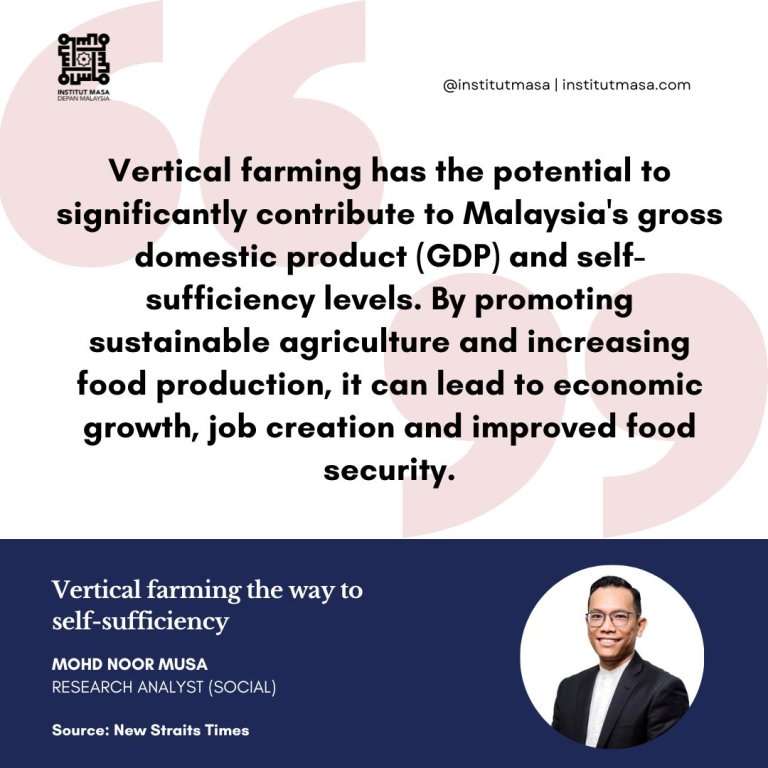By Mohd. Noor Musa
Malaysia is highly dependent on the import of food and beverage products, especially raw materials such as wheat and dairy goods.
According to the Statistics Department, the country’s food imports in 2022 totalled RM75. 6 billion against RM44. 6 billion in exports, which led to an increase of RM31 billion in food product trade deficit, 24.3 per cent higher than in 2021.
As food self-sufficiency in the cities, particularly the Klang Valley, continuously decreases, this is where indoor urban family vertical farming comes in.
In recent years, the indoor vertical farming concept has begun to show its advantages as a promising hope in enhancing people’s food self-sufficiency and alleviating their burden as a result of the high cost of living.
Indoor vertical farming in Malaysia has been gaining traction as a sustainable and efficient method of food production. This innovative approach involves growing crops in vertically stacked layers, allowing for higher yields in smaller spaces compared to traditional farming methods.
There are various methods, such as in urban agriculture through the utilisation of unused spaces like rooftops, walls and indoor facilities. This helps to maximise the use of limited land resources and reduces the need for transportation, thereby minimising carbon footprint.
This concept contributes greatly towards an urban family’s economic feasibility and self-sufficiency. In a way, it helps to enhance the resilience of local food systems.
Many vertical farming projects in Malaysia employ hydroponic and aeroponic systems, which involve growing plants in nutrient-rich water or mist without soil. These methods are highly efficient as they require less water, space and time compared to conventional farming techniques.
To optimise the growth and yield of crops, vertical farms here should integrate advanced technologies such as artificial intelligence, automation and climate control systems.
They help to monitor and maintain ideal growing conditions, ensuring optimal growth and productivity.
Community involvement requires regular initiatives to educate the public about vertical farming and its benefits. Workshops, seminars and demonstrations should be organised to encourage the adoption of sustainable method of food production.
Additionally, community projects and collaborations with schools would help to raise awareness and promote vertical farming as a viable solution in addressing food security issues.
Government support is vital in making this approach a reality as part of efforts to tackle the present high cost of living.
The government recognises the potential of vertical farming and has been supportive of its development. Therefore, policies and incentives should be introduced to promote research, innovation and investment in this sector.
Vertical farming has the potential to significantly contribute to Malaysia’s gross domestic product (GDP) and self-sufficiency levels. By promoting sustainable agriculture and increasing food production, it can lead to economic growth, job creation and improved food security.
As it allows for higher crop yields in smaller spaces, it enables Malaysia to produce more food domestically and in turn reduce our reliance on food imports.
With advanced growing techniques and the ability to produce fresh, high-quality produce all year round, Malaysia could potentially export its vertically farmed produce to other countries, thereby opening up new revenue streams.
The adoption of innovative technologies and sustainable practices in vertical farming can attract foreign investors seeking to collaborate with or invest in this growing sector. This can lead to knowledge transfer, technology advancements and additional capital inflows with positive impact on the nation.
Through increased domestic food production, Malaysia’s food security and systems can be improved, ensuring economic growth and overall well-being. We must be able to adapt to how we farm for sustainability and cost-effectiveness.
Price increases, the ringgit’s continued downward trend and a host of other issues affecting us at present should make us realise that indoor vertical farming is a viable solution to our food miles.
The writer is research analyst at Institut Masa Depan Malaysia (MASA)
